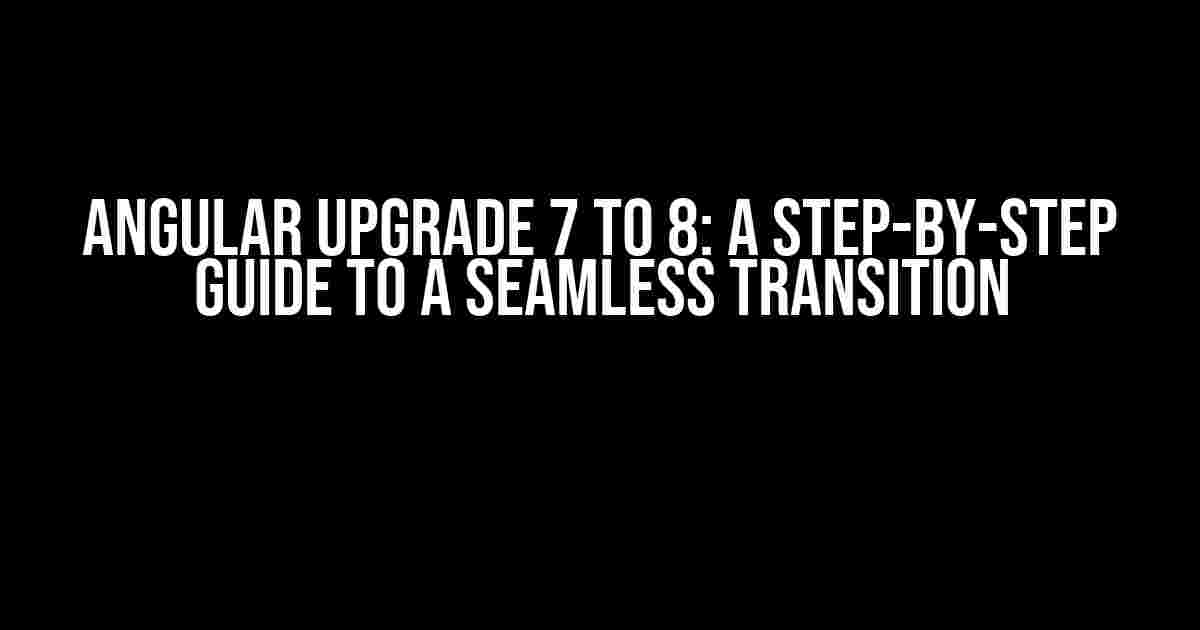Are you ready to take your Angular application to the next level? Upgrading from Angular 7 to Angular 8 can seem like a daunting task, but fear not! In this comprehensive guide, we’ll walk you through the process, providing clear instructions and explanations to ensure a seamless transition.
Why Upgrade to Angular 8?
Before we dive into the upgrade process, let’s talk about the benefits of upgrading to Angular 8. This latest version brings a host of exciting features, including:
- Improved performance and efficiency
- Better support for Ivy, the new rendering engine
- Enhanced TypeScript support
- New features forForms, Animations, and more
With these improvements, you’ll be able to build faster, more efficient, and more scalable applications. So, what are you waiting for? Let’s get started!
Prepare for the Upgrade
Before you begin, make sure you have the following:
- A working Angular 7 project
- A compatible version of Node.js (minimum 10.13.0)
- A compatible version of npm (minimum 6.4.1)
- The Angular CLI installed globally (minimum 7.3.0)
Now, let’s take a deep breath and dive into the upgrade process!
Step 1: Update the Angular CLI
Open your terminal and run the following command to update the Angular CLI:
npm install @angular/cli@8This will ensure you have the latest version of the Angular CLI, which is required for the upgrade process.
Step 2: Update the Angular Core
Next, run the following command to update the Angular core:
ng update @angular/core@8 @angular/common@8This command will update the Angular core and common modules to version 8.
Step 3: Update Other Dependencies
In this step, we’ll update other dependencies, including:
- ROUTER:
ng update @angular/router@8 - FORMS:
ng update @angular/forms@8 - HTTP:
ng update @angular/common/http@8 - MATERIAL (if using):
ng update @angular/material@8
Run each command separately, and make sure to follow the prompts to update each dependency.
Step 4: Update TypeScript
Angular 8 requires TypeScript 3.4 or higher. Run the following command to update TypeScript:
npm install typescript@3.4This will ensure you have the compatible version of TypeScript.
Step 5: Update RxJS
RxJS is a dependency of Angular, and it needs to be updated to version 6.5 or higher. Run the following command:
npm install rxjs@6.5This will update RxJS to the compatible version.
Step 6: Review and Update Your Code
Now that the dependencies are updated, it’s time to review and update your code. Angular 8 introduces some breaking changes, so make sure to check the following:
- The
BrowserModulehas been removed; instead, useCommonModule - The
HTTPClienthas been removed; instead, useHttpClient - Forms have been updated; review your form code to ensure compatibility
Make the necessary changes to your code to ensure it’s compatible with Angular 8.
Step 7: Verify the Upgrade
Finally, run the following command to verify the upgrade:
ng updateThis command will check for any remaining updates and provide a report on the status of your project.
Troubleshooting Common Issues
During the upgrade process, you may encounter some common issues. Here are some troubleshooting tips:
| Issue | Solution |
|---|---|
| Error:Cannot find module ‘typescript’ | Run npm install typescript@3.4 and try again |
| Error:Cannot find module ‘rxjs’ | Run npm install rxjs@6.5 and try again |
| Error: compatibility issues with third-party libraries | Check the library’s documentation for Angular 8 compatibility and update accordingly |
If you encounter any issues not listed here, refer to the Angular documentation or seek help from the community.
Conclusion
Congratulations! You’ve successfully upgraded your Angular 7 project to Angular 8. Take a moment to celebrate this achievement, and then get back to building amazing applications with the latest features and improvements.
Remember, upgrading to Angular 8 is a process that requires patience, attention to detail, and a willingness to learn. With this guide, you’ve taken the first step towards a seamless transition. Happy coding!
Here are the 5 Questions and Answers about “Angular upgrade 7 to 8” in HTML format:
Frequently Asked Question
Get ready to take your Angular skills to the next level! Upgrading from Angular 7 to 8 can be a breeze with these frequently asked questions.
What are the key benefits of upgrading from Angular 7 to 8?
Upgrading to Angular 8 brings several advantages, including improved performance, better error handling, and enhanced support for Ivy, a next-generation renderer. Additionally, Angular 8 introduces a new rendering pipeline that speeds up the development process and reduces the size of the generated code.
What are the minimum requirements for upgrading to Angular 8?
To upgrade to Angular 8, you’ll need to ensure that your project meets the minimum requirements, which include Node.js 12.13.0 or later, TypeScript 3.6.4 or later, and a compatible version of the Angular CLI. It’s also recommended to have a compatible version of other dependencies, such as RxJS and Zone.js.
How do I upgrade my Angular 7 project to Angular 8?
Upgrading your Angular 7 project to Angular 8 involves several steps. First, update your project dependencies by running the command npm install @angular/cli@8 @angular/core@8. Next, update your Angular CLI to the latest version by running the command ng update @angular/cli@8. Finally, run the command ng update @angular/core@8 to update your Angular core module.
Will my Angular 7 project work with Angular 8?
Most Angular 7 projects will work with Angular 8 without significant changes. However, some deprecated APIs and features have been removed in Angular 8, so you may need to make some adjustments to your code to ensure compatibility. Additionally, if you’re using third-party libraries, you may need to update them to versions compatible with Angular 8.
What kind of support can I expect for Angular 7 after upgrading to Angular 8?
After upgrading to Angular 8, you can still expect support for Angular 7, including security patches and bug fixes, for a period of 12 months from the release date of Angular 8. However, it’s recommended to upgrade to Angular 8 as soon as possible to take advantage of the latest features and improvements.
